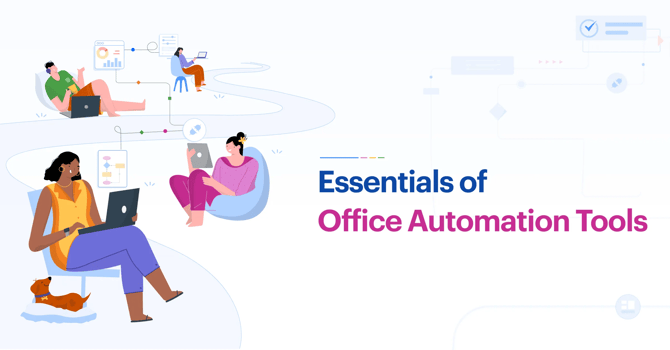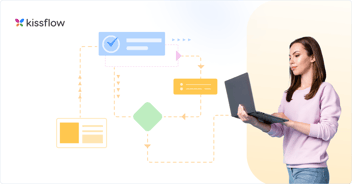
- >
- Workflow Platform >
- Office Automation System in 2025: 5 Essentials & Why It Matters
Office Automation System in 2025: 5 Essentials & Why It Matters
Team Kissflow
Updated on 13 Jun 2025 • 7 min read
What is office automation?
Office automation is the process of watching data flow around on its own without any human intervention, inaccuracies, and errors. It is the process of using an automation tool to create, collect, store, analyze, and share confidential office data that is required to accomplish basic day-to-day routine tasks and processes effectively.
Technology has made a serious impact on the daily work of office administration. Emails have replaced memos, shared drives have done away with filing cabinets, and biometrics have taken over employee timesheet stamping. Many businesses think that they have attained office automation nirvana simply by going paperless.
But office automation is a different ballgame altogether.
Using online forms and sending Google Calendar invites might mean that you’ve ditched a lot of paper, but it doesn’t mean you are automated. It just means that instead of pushing around the paper, you are pushing around data.
Handling work electronically doesn’t mean your office is automated. ![]()
What is an office automation system?
An office automation system is a tool that enables data to move from one system to another on its own without human intervention and inaccuracies. These tools help organizations collect, manage, and analyze securely to accomplish everyday tasks and processes. It optimizes and automates existing business processes and procedures.
Why Cloud Office Automation?
Cloud office automation enables businesses to take advantage of remote work, with all tools and systems available from anywhere with an internet connection. This method increases collaboration between teams, reduces the need for expensive on-premise infrastructure, and offers unparalleled scalability. Cloud-based solutions, such as document management systems and communication platforms, allow companies to automate their operations while maintaining access to real-time data and analytics.
Forrester predicts that by 2025, citizen developers will deliver 30%[1] of generative AI-infused automation applications, highlighting a shift toward democratized automation development.
Why use an office automation system?
In today’s digital age, office automation systems offer an array of benefits for organizations of every size. Powerful office automation systems reduce manual effort and store a large amount of data in little space. They not only streamline day-to-day tasks but also speed up information retrieval. Additionally, these tools improve process visibility and help businesses spot bottlenecks easily.
On the other hand, you could be watching data flow around on its own – that’s automation.
Benefits of Office Automation
The benefits of an automated office go far beyond just reducing manual effort. Automation can dramatically increase productivity by freeing up employees to focus on more strategic tasks. Additionally, it helps improve accuracy and reduces human errors in daily operations. Automated systems also contribute to faster decision-making, cost savings, and greater scalability as your business grows. Some of the biggest advantages of automating office workflows include
-
Reducing the manual effort to complete mundane tasks
-
Cutting down on manual errors
-
Shrinking the processing time for items
-
Getting insights into process performance metrics
-
Gaining greater process visibility and identifying potential bottlenecks
-
Making sound business decisions based on data
Office automation adds efficiency to your workflows, but you need to look beyond emails and digital forms to really embrace it.
If you are looking for an office automation solution that can take your company workflows to the next level, don’t settle for anything that doesn’t have these five essentials. Learn More About Kissflow’s Low-Code Platform and its benefits.
| Check Out: 10 Benefits of Workflow Management System
Office automation equipments
Office automation equipment includes a variety of devices that help streamline office processes. For instance, modern printers and scanners that are connected to cloud-based systems allow for automatic document filing and sharing. Fax machines with integrated electronic systems, smart devices, and IoT equipment also play a crucial role in reducing manual tasks. All these devices work in tandem with office automation software to provide a simplified workflow.
The 5 Essentials of Office Automation Tools
 1. Easy workflow designer
1. Easy workflow designer
Creating workflows used to be the domain of hard-core system coders. So, as workflow software evolved, it assumed the people using it would be programmers as well.
However, a modern office automation system should start with the business user in mind, not the coder.
When you sit down to trial an office automation tool, start off by making your own workflows. How easy is it? Can you intuitively create the sequence of tasks needed to finish a process? If you can’t figure it out within the first five minutes, you need to move on to the next option.
A piece of software shouldn’t determine how your business should set its operations. It should instead aid your teams to strengthen the existing processes.
2. Mobile compatibility
Your office is mobile, and all your tools should be too. Whether you have remote workers or you just want to check in while waiting for a flight, the office automation tool you choose should work just as smoothly on someone’s phone while on a trip to China as it does on a PC at the main office.
Your marketing campaign can’t be delayed a day just because you need to wait for Greg to get back from his vacation in Machu Picchu.
You should be able to run your core processes from a secure cloud and never have to worry about where your data is or who is protecting it. If you use an office automation tool like Kissflow Workflow, then Greg can go over the marketing plan on his mobile from his hotel lobby in Peru and give his nod before he goes on to take selfies with the llamas.
3. Integration with other software
Office automation software isn’t the only thing you are running. You’ve got your internal database, a CRM, a marketing automation tool, and your financial software, and that’s just for starters. When you’re reliant on so many systems, you need a tool that doesn’t just keep to itself.
Of all the software out there, office automation should be the easiest to integrate with your other tools. If it doesn’t, you are stuck pushing data around from one system to another.
When doing an evaluation, see what kind of pre-integrations the office automation software provides, or if it takes advantage of connecting to a tool like Zapier to open access to thousands of other cloud tools.
4. Reports and analytics
How do you know if your office automation is yielding results? You can’t just evaluate process performance based on how happy your team is. Data is the ultimate decision-maker, and it’s important for your business to compare a process’ history, its speed, the outcome quality, etc.
Adopting another software to measure your workflow data is time-consuming and unnecessary. Why not have a single piece of software that comes embedded with reporting and analytics features? The best office automation products now come equipped with this feature as part of their fundamental offering.
5. Access control options
Just like limiting entry to your office premises, you should also have access privileges set to all of your business workflows.
A good workflow automation system understands this sensitive requirement and will have access control as part of its integral features. Don’t overlook this capability when considering office automation software for your business.
To discover the 5 essentials of workflow software for office automation.
To explore how automation tools support office productivity, this Power Automate guide offers a complete look into workflow automation strategies.
What are the functions of office automation software?
An ideal office automation software:
-
Requires less space to store data
-
Streamlines data storage and retrieval
-
Retrieves information instantly
-
Eliminates the need to preserve paperwork
-
Removes any chance for data redundancy
-
Allows multiple people to access data
-
Reduces the possibility of errors
Office automation examples
There are numerous examples of office automation used across different industries. For example:
- HR Automation: Automatically process employee timecards, handle payroll, and onboard new employees.
- Finance Automation: Automatically generate invoices, process payments, and manage budgets.
- Sales Automation: Lead scoring, customer follow-up, and automated reporting.
- Marketing Automation: Automatically send out email campaigns, schedule social media posts, and analyze customer behavior.
| Read More: 10 Workflow Examples You Can’t Ignore
Save money, save time, and step into the future
If you have been fooled into thinking your office is automated, when it’s really just digitized, It’s time to upgrade your workflows and take the leap towards office automation.
Offices that automate can save a tremendous amount of time and money and let their workforce focus on the things that actually bring value to the company. Try Kissflow's Workflow today and see how far you can go with office automation.
Businesses rely on Process Owners and Managers to optimize operations and improve efficiency. A low-code system approach makes workflow automation easier than ever find out how kissflow transform processs management.
FAQs- Office workflow automation
1. What are the types of office automation?
There are 4 crucial types of office automation- Electronic publishing, Collaboration, Document workflows, Office management
2. Why office workflows are important?
Office workflows are a crucial component in streamlining office operations. They help maximize productivity, eliminate human errors, reduce stress, remove process redundancies, and help drive actionable insights that boost efficiency. Overall, they help organizations pivot, sharpen decision-making, and drive positive impact.
3. What are the benefits of an automated office?
Increased Efficiency, Cost Savings, Improved Communication, Better Customer Service and Increased Productivity
4. What are the basics of office automation?
Document Management, Communication Tools, Task Management, Customer Relationship Management (CRM), Human Resource Management (HRM) and Workflow Management
5. What are the top office automation tools in 2025?
Workflow automation tools with deep productivity suite integration lead the market. Simple integration platforms remain popular, while advanced workflow builders excel for complex scenarios. Document automation has expanded beyond signatures into comprehensive agreement management. For AI assistants, integrated office suites are transforming how knowledge workers handle routine tasks.
6. How does AI improve office automation?
AI elevates office automation from simple rule-based tasks to intelligent processes. Document processing systems now understand content context, not just keywords. Email management tools prioritize messages based on urgency and relevance. Meeting assistants generate actionable summaries and follow-ups. Even customer service automation has become remarkably human-like, handling complex interactions without frustrating customers.
7. What industries benefit most from office automation?
Financial services firms see massive efficiency gains from automating document-heavy processes like loan applications. Healthcare organizations use automation to streamline patient intake and insurance verification. Legal practices dramatically reduce contract review time with AI-powered tools. Even manufacturing companies benefit from automating their back-office functions like procurement and inventory management.
8. What are common challenges in automating office workflows?
Integration issues between different systems often create digital bottlenecks. Legacy systems with limited APIs can be automation roadblocks. Employee resistance remains significant when automation threatens familiar routines. Data security concerns grow as workflows span multiple services. Perhaps most challenging is maintaining the human touch in customer-facing processes despite increasing automation.
9. How can small businesses use office automation effectively?
Small businesses should start with their most painful manual processes – usually invoicing, appointment scheduling, or data entry. Low-code platforms offer affordable entry points without technical expertise. Focusing on customer-facing automation typically delivers the fastest ROI. Start small, measure results, and expand gradually rather than attempting a comprehensive overhaul that overwhelms limited resources.
Explore Cost-Effective Workflow Platform Pricing Options
Kissflow's advanced automation of all processes is easy to set up. I cannot imagine how I will manage workflows without this software.
- Frederic J
Thanks for submitting.
Our solution experts will connect with you to get started.
Related Articles











